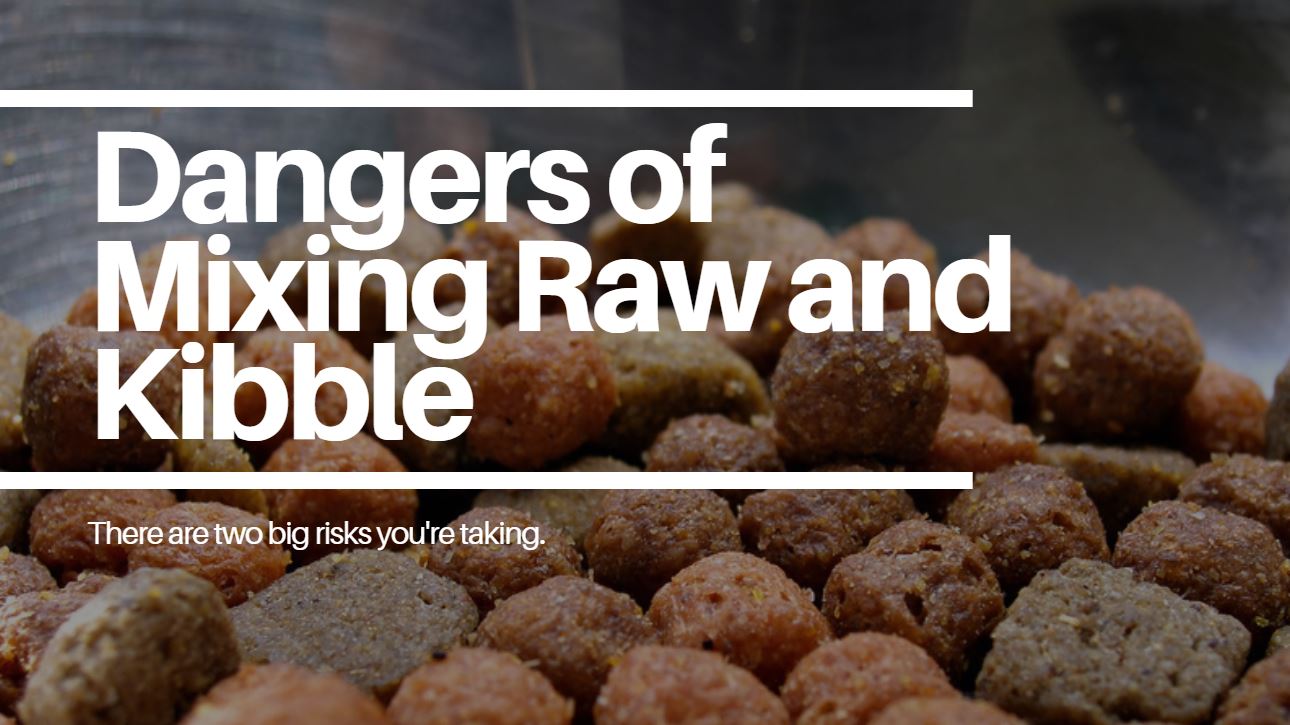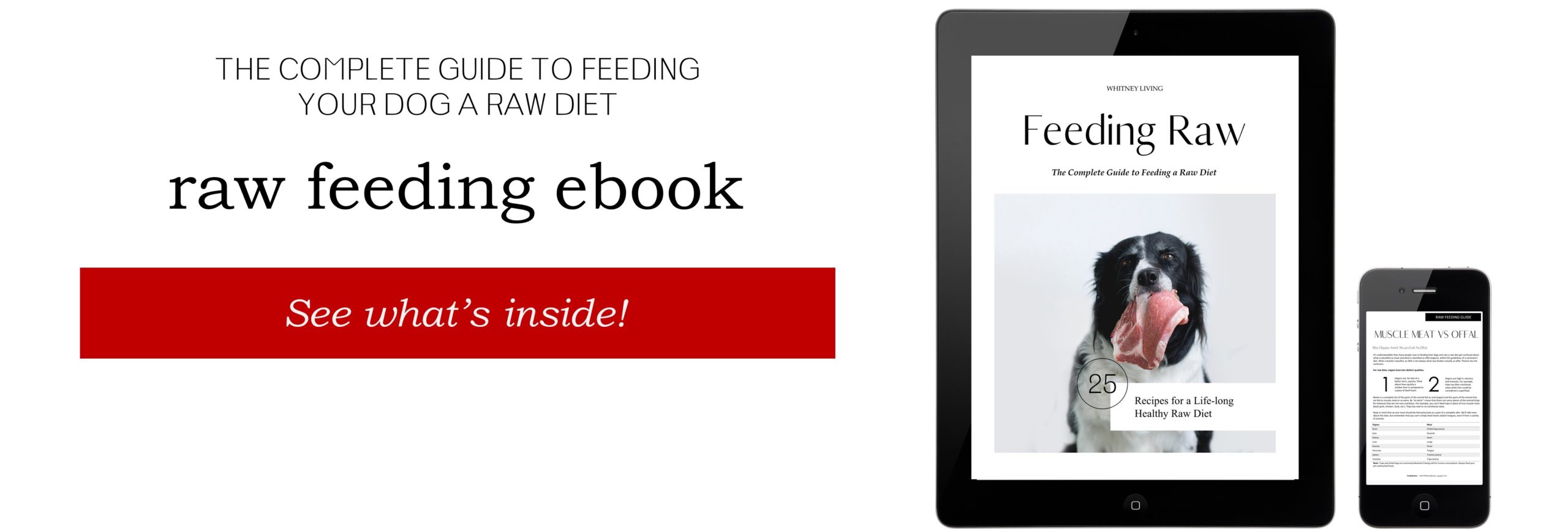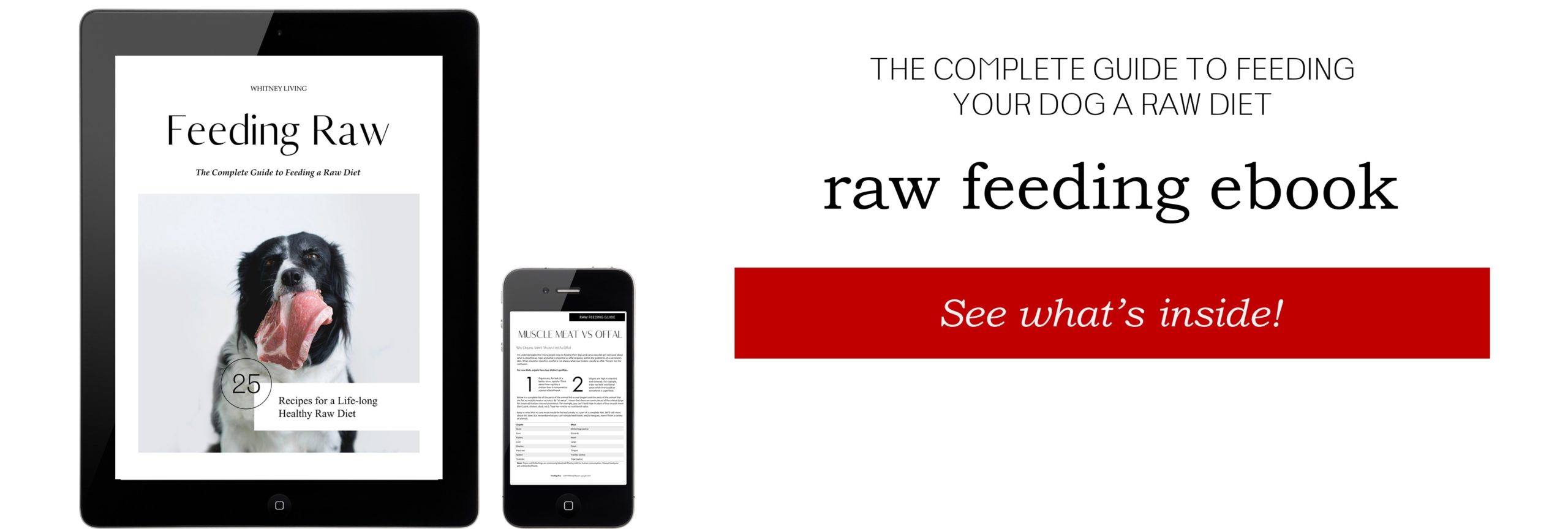You may be asking yourself right now, what’s the harm in feeding kibble in the morning and raw at night?
I’m going to tell you the two big dangers of feeding a diet of processed food and raw food whether you’re feeding kibble in the morning and raw at night or you’re feeding them both in the same meal. But first, let me put to bed a very silly theory being thrown around as if it’s a cold, hard fact.
Forget this Very Silly Theory
Silly Theory: It’s not a good idea to mix raw food and kibble in the same meal because kibble takes longer to digest and can cause digestive distress when mixed with raw.
Common Sense: Meats, bones, organs, eggs and bone broth are all digested at different rates. Bones don’t pass through the body as quickly as raw eggs. That’s just common sense.
It’s not the speed of digestion that’s the issue. It’s the highly processed, denatured, rancid kibble that’s being combined with food in its natural form that’s the problem!
I am very much against mixing raw and processed foods for two very important reasons that I’ll share below, but I’m not going to feed you (no pun intended) a ridiculous theory in order to make a point!
I’m a big fan of two things:
- Proven Facts
- Common Sense
And that’s what I promise to give you with every word I write.
So, let’s cover the two common sense dangers (backed by facts) of feeding kibble in the morning and raw at night, vice versa or both at the same time!
-
Undigested Bones
In feeding a raw diet made up of roughly 10% bone matter, you’re challenging your dog’s digestive system to break down, digest and utilize one of the toughest foods he can consume. In order to safely consume raw bones, your dog’s digestive system must be healthy. This means that his stomach bacteria must be strong and durable.
The last thing you want to happen is for undigested bone shards to pass through your dog’s digestive tract because they can cause damage to the intestines or rectum.
When you feed a processed diet of canned food or kibble your dog’s digestive system is being weakened. Processed foods wreak havoc on the body whether you’re an herbivore, omnivore or carnivore.
Your dog’s body doesn’t see kibble as digestible. When your dog’s gut doesn’t recognize what they’ve eaten as digestible food their body instead interprets the presence of foods like highly processed meats or artificial ingredients as an “attacker.”
This sets off an inflammatory response in which the body fights these foods as if they were an infection.
Because the gut bacteria develop and die off very quickly this means that everything your dog eats will alter his good bacteria on a daily basis. I tell you this to iterate that you can either damage your dog’s digestive system by feeding a processed diet or you can improve and heal your dog’s digestive system by feeding a proper raw diet, and you cause this change in your dog’s gut with each and every meal you feed.
So, if you feed kibble in the morning and raw at night you are damaging your dog’s good gut bacteria by feeding kibble and it is then weakened and more susceptible to illness and disease, then you’re feeding raw foods that require a healthy digestive system to break them down.
You’re essentially playing roulette with your dog’s health.
In my eBook, I talk about how important a proper transition to raw is for your dog. When done correctly your dog is safe. When done wrong your dog can suffer painful and long-term consequences. The same rationale applies here.
-
Bad Bacteria
In the documentary Food, Inc. Joel Salatin talks about having his pasture-raised chickens—that are butchered in an open-air processing station—cultured to compare them to commercially raised chickens processed in plants.
The results showed that Joel’s chicken averaged 133 CFU (colony-forming unit: a unit used to estimate the number of viable bacteria or fungal cells in a sample) while the commercially raised and commercially processed chickens averaged 3,600 CFU. Joel adds “…those have been through 40 chlorine baths and ours haven’t seen any chlorine.”
Again, that’s 133 bacteria/fungal cells vs 3,600 bacteria/fungal cells, per sample.
While your carnivore has the ability to safely ingest and pass higher levels of harmful bacteria than you, it’s still important to take safety measures when feeding a raw diet. This includes never combining processed food with raw food.
Why, you ask? For the same reason that I mentioned above (and will give you more detailed info about, below). Your dog needs an ironclad digestive system to ward off and safely pass bacteria in raw animal products. When your dog’s immunity is weakened by processed food it loses its strength and your dog is more susceptible to illness and disease.
If you’re feeding Joel’s chicken or raising your own chickens in clean, natural environments then your dog is all the safer, but chances are you’re buying commercially raised and processed meats. Meats that average 3,600 bacterial/fungal cells per sample.
The last thing you want to do is weaken your dog’s immune system by feeding kibble in the morning and raw at night before feeding raw meats that contain any levels of bacteria, let alone unnaturally elevated levels.
But Can I Get Away with It?
You can always get away with something until you can’t.
My Great Uncle famously smoked a pack (or two) of cigarettes a day and ate biscuits and sausage every single morning. He was “the picture of health” until the day that he wasn’t. He died of major heart issues.
So yes, you can “get away” with anything, until the day you can’t.
I don’t take risks with my dogs. Their lives are too valuable to me.
Mixing kibble and raw is a risky move for the two reasons I’ve clarified above, and a risk I highly recommend you don’t take.
But It’s Cheaper for Me to Mix Raw and Kibble
No, it’s not.
I hate to break it to you, but if you haven’t cut your food costs by as much as 80% by switching to raw, you’re not taking advantage of all the resources available to you.
I’ve shared 101 ways for you to save money on raw feeding. These proven tips are what easily helped me dramatically cut raw feeding costs. Like I say in the post, if you do nothing else, do at least the first 5 things.
The Absence of Disease is not Health
Let’s talk more about gut bacteria.
Mixing raw and kibble will also cost you in the long run. Just because your dog looks and acts okay today, doesn’t mean he’s in optimal health.
In 2016 Harvard Medical School published a piece on gut bacteria and health.
Here are several findings they shared about gut health:
“A study published online April 21, 2016, by Genome Medicine looked for a biomarker of the disease. Researchers were able to isolate certain bacteria that are high in rheumatoid arthritis patients but low in healthy individuals.
A study published online June 23, 2016, by Arthritis & Rheumatology, found that mice treated with the bacterium Prevotella histicola had less severe and less frequent symptoms of rheumatoid arthritis and fewer inflammatory conditions associated with RA.
A study published online April 13, 2016, by PLOS ONE offered some evidence that a particular strain of the bacterium Lactobacillus johnsonii may protect against some cancers.
Research in the February 2016 Journal of Applied Microbiology found the bacterial strain Akkermansia muciniphila could prevent inflammation that contributes to fatty plaque buildup in arteries, causing heart disease. Scientists believe the effect was due to a protein that blocks communication between cells in the inner lining of the gut. As a result, fewer toxins from a poor diet could pass into the bloodstream, which in turn reduced inflammation.
In a study published online Nov. 5, 2015, by Science, University of Chicago researchers found that introducing a particular bacterial strain into the digestive tracts of mice with melanoma prompted their immune systems to attack tumor cells. The gains were comparable to treatment with anti-cancer drugs.”
While these studies were not done on carnivores, common sense tells us that gut bacteria is linked to health in all animals.
Before you take a big risk in feeding kibble in the morning and raw at night, consider all of these facts. I know you’re like me and want the best for your pets. We both want our dogs to live long, pain-free lives and we want them to grow old without illness. Let’s always do right by them!



I understand the ‘not mixing’ of raw and kibble, but what would you suggest as training treats please?
I make homemade dehydrated treats for my boys out of chicken or beef. I like using beef heart most because it’s inexpensive and dehydrates best for me. I also raise quail. They lay small eggs that are the perfect size for treats.
Hi, would I be able to feed my dog kibble in the morning and raw at night? That gives them at least ten hours to digest everything in between meals? I have read a few other articles that have said feeding them this way would be fine.
Hi there, Madison! The article is very clear about the risks of feeding both. It doesn’t matter how much time is in between meals. Yes, there are likely 100s of articles that say you can feed both. There are also 100s or even 1,000s of articles on the world wide web that claim the earth is flat. Such articles are opinion-based. The above article explains the dangers in full and is not an opinion piece. It’s important to recognize the difference.
There’s so many different opinions on this. Some say its OK. Some say it’s not. My pups vet today said it’s fine to feed a mixture of raw with kibble. So whom am I supposed to believe
Hey Sandy! Opinions are worthless. Most vets (and I do mean most) have little to no knowledge about canine nutrition. I recently helped a dog who was fed both kibble and raw. He was 16 lbs. and was passing undigested bones that were up to 3 inches long. I’m sure you can imagine how scary that was! His system couldn’t completely break the bones down and they were passing through his entire digestive tract. The fix was easy. Eliminate the kibble. Problem solved. Like I said, opinions are worthless. And always consider the source. Until recently, I have personally never had a vet that was knowledgeable in this area. I just spoke with one last week who was was completely uneducated in canine nutrition and didn’t even understand basic things like the difference between vitamins K1 and K2. Ask your vet how much vitamin D your dog needs on a daily basis. Most vets don’t know. If they don’t know something that simple, how can we trust them to know anything beyond that?
I love this article! Question: i dont give maggie bones, or even raw, for that reason. I cook and mix homemade food of lean ground grassfed beef, brown rice, hard boiled eggs, diced fresh carrots, thawed frozen green beans, chopped fresh parsley, and safflower oil. Top it with “DOG GREENS”, a digestive probiotic chewy, and a few squirts of pure salmon oil that comes mixed with a mushroom blend and organic apple cider vinegar. Thats just dinner. She gets oatmeal, eggs, fresh berries, greek yogurt, pumpkin puree, and ground flax with the same toppings for breakfast. Can I alternate dinners with raw freeze dried like stella and chewys or ziwi every other day?
Hey there, Annette. Unfortunately, you’re feeding so many things that are going to negatively impact your dog’s health and cause premature aging along with potentially causing illness and disease that what you mix is the least of your worries. This is a lot to break down but I’d be happy to if you’d like the help. Who is advising you?
I would love enlist in your guidance. Ive decreased the amount of different ingredients in maggies diet. But she is still getting fresh food with great toppers from trudog and hungry bark. She gets some pumpkin puree, fresh blueberries, and plain greek yogurt with a raw freeze dried beef topper in the morning, and raw freeze dried from either truedog (rawgo) thats mixed with a liquid of organic beef bone broth or stella and chewys in the evening. I add a tiny bit of essential RX vitamin powder in the morning and a probiotic. I add mushroom blend liquid and salmon oil at night. Ive spent countless hours researching healthy treats and really wanted to give her coconut treats with no fillers, all natural. I check and make sure theres no extra ingredients or nasty processed stuff in them. Her treats are by Einstein’s pets. Even if I do make her some meatloaf (shes does not tolerate chicken at all) its only grass fed ORGANIC ground beef with unprocessed green beans, small amount of fresh cooked oatmeal, pumpkin puree, and some fresh blueberries, then cooked at 250 until the thermometer reads 160 farenheit. I’ve been looking for someone to help because my vet seems to be completely unable to advise when I ask.
Hi there, Annette. Most of what you’re feeding is not healthy for your dog. I see that you’re really trying to do all the right things for her. Unfortunately, almost everything you’re feeding needs to be eliminated. It’s doing her no favors. First things first, I never recommend feeding food products that are made for pets. Never. Here’s the best place to start: https://whitneyliving.com/foods-your-dog-is-dying-for
I feed my 132 lb 2yr old, male rottweiler, Roman, twice a day, about 1 lb of meat each meal. I’m so thankful I came across this article bc I’ve been feeding him kibble with raw. Many times, after drinking water, he vomits undigested pieces of swollen kibble. Never meat- just drool, water & kibble. Now I know why. Thank you! He has a chicken sensitivity, from being fed cooked chicken as a puppy. He had yeast ear infection until I eliminated all poultry. I give him raw egg yolk, @ 2×/wk . His meals mainly consist of 60% raw beef heart & ground beef, 30% raw beef kidney or liver, and a raw beefy neck bone afterwards-keeps his teeth very white. I grind whole flax seed and mix it in his food & also give him a couple tbsp of cooked vegetables- he only likes broccoli, green beans, carrot or sweet potato- he won’t eat any fruit, except peeled cut up apple. Is there anything I should add or remove? He looks very healthy – shiny coat- I can feel his ribs- is very energetic- we go to the beach a lot! He has so much extra skin, though, I just want to know if he’s getting the correct nutrition. Thank you in advance. I’d appreciate any advice.
Hi Anna! You’re on the right track! Remove all plant foods (flax, vegetables, etc.). He’s a carnivore. https://whitneyliving.com/feeding-dogs-fruits-vegetables/